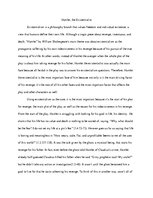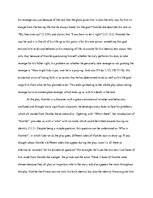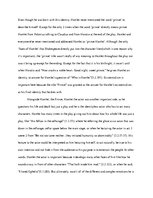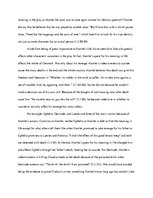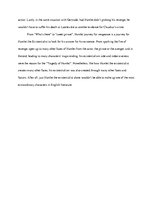-
Shakespeare "Hamlet"
Bezmaksas!Eseja4 Literatūra, Tulkošana, valodniecība, Vēsture, kultūra
For example, Ophelia, Gertrude, and Laertes are three of the main victims because of Hamlet’s actions. Common to Hamlet, neither Ophelia or Hamlet is able to find the meaning in life except for what others tell them like when Hamlet promised to take revenge for his father or Ophelia promises to Laertes and Polonius “I shall the effect of this good lesson keep” and both are obsessed with death (1.3.49). In the end, Hamlet’s quest for his meaning in life changed him and affects Ophelia through her father’s death, leading her to suicide. For Gertrude, Hamlet’s indecisiveness in killing Claudius leads to her death because of the poisoned drink when Gertrude screams out “The drink, the drink! I am poisoned” (5.2.341). She would have avoided being the evidence to prove Cladius’s crime, something Hamlet knows long ago but couldn’t take action. Lastly, in the same situation with Gertrude, had Hamlet didn’t prolong his revenge, he wouldn’t have to suffer his death or Laertes die as another evidence for Claudius’s crime.
From “Who’s there” to “sweet prince”, Hamlet journey for vengeance is a journey for Hamlet the Existentialist to look for his answer for his existence. From sparking the fire of revenge, open up to many other faces of Hamlet from the actor, the prince or the avenger, and in the end, leading to many characters’ tragic ending, his existentialism side and indecisiveness were the reason for the “Tragedy of Hamlet”. Nonetheless, like how Hamlet the existentialist creates many other faces, his existentialism was also created through many other faces and factors. After all, just Hamlet the existentialist alone wouldn’t be able to make up one of the most extraordinary characters in English literature.
…
Hamlet analysis essay

